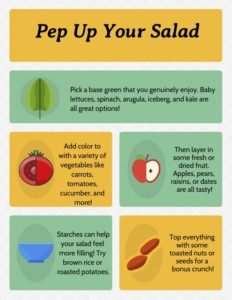Cold Weather Salad Tips
Does this colder weather make you or your clients shy away from salads?We're here to help!After all, salads aren’t just for spring or summer and they don’t always have to be cold! Salads can include both raw and cooked vegetables, tubers, grains and a variety of fresh or dried fruit. They may also include nuts or seeds, dairy products, beans, or even lentils.Research shows that a diet high in fruits and vegetables is not only beneficial in reducing the risk of cancer, diabetes, and heart disease, but also depression. A study in young adults aged 18 to 25 in the US found that those with highest consumption of raw fruits and vegetables had higher positive moods and lower symptoms of depression.So, lettuce explore what makes a great salad!All About That Base: Iceberg lettuce often gets dissed as pointless because it’s not as nutritious as spinach, kale, or arugula. Does that matter? Maybe, but maybe not. Iceberg can be a vehicle to support other more nutrient-dense veggies. Why not add chopped tomatoes, shredded cabbage, pepper strips, or other greens to a base of iceberg lettuce?Arugula makes a great salad base with its soft texture and peppery taste. “Pear” it with chunks of pears, or apples, chopped walnuts or pecans, a handful of blue cheese crumbles, and a drizzle of balsamic vinaigrette.Kale is a great salad base, but needs a little TLC to soften its rough edges. After cleaning and ripping kale for salad, place it in a zip lock bag and massage it for a few minutes until it’s shiny. This will help to wilt the kale, which softens the texture and sweetens the taste a bit. Kale salads can be dressed ahead of time, which help them wilt as well.Spinach is a good source of beta-carotene, potassium, and vitamin C and makes a pretty base for multiple salads. Like arugula, spinach goes well with sweet or savory fixings. Try it with hard-boiled eggs or chunks of albacore tuna and a mustard dressing.Add Color:The more colorful your salad, the more enticing it looks to eat and more nutritious it becomes.
- Add chunks of cucumbers, grape tomatoes, avocado slices, green or kalamata olives, or pickled onions to your greens.
- Chickpeas, black beans, lentils, or kidney beans also add color in addition to soluble fiber, zinc and protein to your salad.
- Try chopped apricots, dried cherries, raisins or dates in your next bowl. Mandarin oranges, grapefruit, cara cara or blood oranges add color and texture as well as vitamin C, and potassium to your bowl. Fruit goes well with a ginger-based or citrus dressing.
- Almond slivers, pumpkin seeds, and chopped walnuts, oh my! Nuts and seeds of all kinds are a great addition to salads. They add crunch and color to your bowl as well as magnesium, zinc, and fiber.
Make It a Meal:Whether you call it a grain bowl or hearty salad, adding grains to greens gives your meal great texture, color and substance. Cooled quinoa or brown rice are gluten-free options that provide fiber and complex carbohydrates. Golden potatoes go well with green beans for a savory salad while sweet potatoes pair well with citrus and greens.Adding a bit of strong cheese like Parmesan, Asiago, blue cheese or feta gives a salad an extra kick of flavor too.Blue cheese often goes well with salads containing fruit while Parmesan, Asiago and feta cheese are nice in salads with tomatoes and cucumbers.Drizzle, Don’t DrownA perfect salad dressing coats your greens, grains, fruit and more but doesn’t cause your salad to go soggy. Combine equal parts of your favorite acid (citrus juice or vinegar) with your oil of choice (canola, olive, peanut or sesame) and whisk it all together! Add-ins like a shot of Dijon mustard, grated ginger or Greek yogurt add taste, tang, and texture to your dressing.No matter what you add to your salad, go for more fruits and vegetables every day!By Lisa Andrews, MEd, RD, LDReference:Brookie KL, Best GI, Conner TS. Intake of Raw Fruits and Vegetables Is Associated With Better Mental Health Than Intake of Processed Fruits and Vegetables. Front Psychol. 2018 Apr 10;9:487. doi: 10.3389/fpsyg.2018.00487. PMID: 29692750; PMCID: PMC5902672.Remember to download your free handout!


